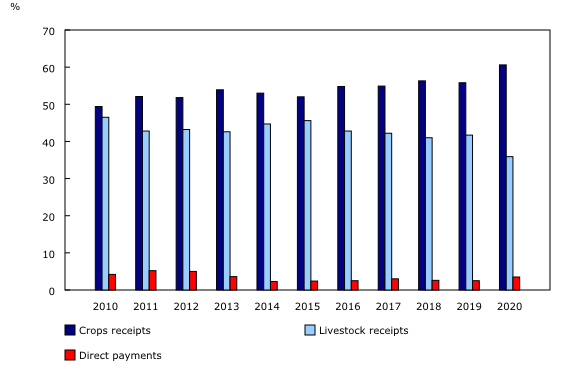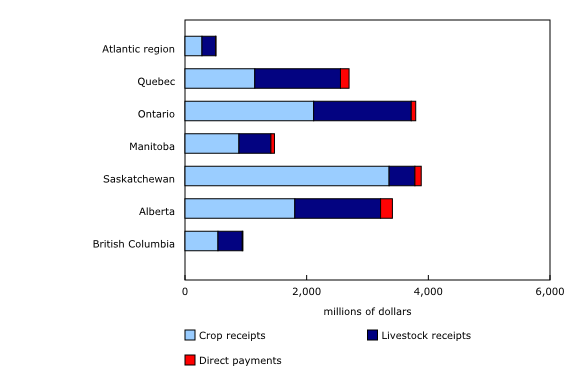Farm cash receipts, second quarter 2020
Archived Content
Information identified as archived is provided for reference, research or recordkeeping purposes. It is not subject to the Government of Canada Web Standards and has not been altered or updated since it was archived. Please "contact us" to request a format other than those available.
Released: 2020-08-28
$16.7 billion
April to June 2020
5.2% 
(year-over-year change)
Farm cash receipts totalled $16.7 billion in the second quarter, up 5.2% from the same period in 2019—despite the challenges posed by the pandemic. Higher crop receipts (+$1.3 billion) and total direct payments (+$187.2 million) more than offset a $628.9-million decrease in livestock receipts.
COVID-19 has disrupted food supply chains and created farm labour shortages in greenhouses and farms. The impact of the pandemic on farm receipts will vary by commodity and, in certain cases (e.g., labour shortages in horticulture), will not be reflected fully in the data until later in the production year.
Although farm cash receipts only increased in four provinces, these increases were large enough to offset decreases in the other six provinces. Saskatchewan led the provinces, with an increase of $878.9 million on the strength of crop receipts for wheat, canola and lentils. Lower hog receipts resulted in a decrease in Manitoba (-$101.3 million), while lower cattle and calf receipts affected Alberta (-$60.6 million).
Lentil and canola receipts push crop receipts higher
Crop receipts rose by $1.3 billion in the second quarter of 2020 compared with the same quarter in 2019. Crop receipts were higher because of lentils (+$408.5 million), canola (+$249.8 million) and cannabis (+$685.0 million).
Lentil receipts more than tripled in the second quarter, to reach $604.6 million. Exports to India and Turkey boosted demand as marketings more than doubled and prices increased by more than 40%.
Canola receipts rose 12.2% year over year. Marketings were up 13.3% despite the ongoing trade dispute with China. Exports to China increased in the first and second quarters of 2020, and higher exports to other countries offset the lower demand from China. With one month remaining in the crop year (July), canola crushing for the current crop year has already surpassed the record crushing recorded in the 2018/2019 crop year.
The demand for cannabis received a boost in late 2019 and early 2020 when cannabis-based drinks, edibles and topicals entered the market. While the sale of these products is not included in farm cash receipts, the resulting rise in dried cannabis marketings pushed receipts up $685.0 million year over year, to $1.1 billion.
Receipts for wheat (except durum) rose 7.8%, to $1.5 billion, on higher marketings (+14.6%), while durum wheat sales increased by 20.7%, to $415.4 million, on higher marketings (+6.6%) and prices (+13.2%). Wheat (except durum) flour is one of the main ingredients in home-baked goods, while durum wheat is used in the processing of shelf-stable foods like pasta. Demand for these items increased when stay-at-home orders were introduced around the world, leading consumers to stockpile these types of goods.
Crop receipts were led by year-over-year increases in Saskatchewan (+$926.7 million) and Alberta (+$196.6 million) in the second quarter. Receipts fell in three provinces: Manitoba (-$39.4 million), British Columbia (-$7.2 million) and Newfoundland and Labrador (-$0.7 million).
Livestock receipts fall as COVID-19 outbreaks impact cattle and calf receipts and hog prices
Livestock receipts were down by 9.5%, to $6.0 billion, in the second quarter of 2020 compared with the same quarter of 2019. This decrease was largely attributable to lower receipts for cattle and calves (-18.2%) and hogs (-14.2%).
Cattle and calf receipts were down $416.5 million, to $1.9 billion, on lower marketings and prices. Slaughter marketings and prices accounted for most of this decline as meat-packing capacity was reduced by outbreaks of COVID-19 in the second quarter.
Lower prices pushed hog receipts down $184.4 million, to $1.1 billion. Marketings were up 5.0% while prices fell 18.2% in the wake of temporary closures of some processing plants and lower processing capacity at other facilities across North America because of the COVID-19 pandemic.
Receipts for all supply-managed sectors, which accounted for a little over 47% of total livestock receipts, were relatively stable in the second quarter. Egg receipts rose 4.7% on higher marketings (+4.2%). The increase in the chicken prices (+4.8%) outpaced the drop in marketings (-4.4%). Milk receipts edged down 0.8% on lower marketings (-1.4%).
Livestock receipts were down in nine provinces, led by Alberta (-$346.0 million), Manitoba (-$97.5 million), Ontario (-$86.4 million) and Saskatchewan (-$74.8 million). Quebec was the only province where livestock receipts were unchanged from the same quarter last year.
Program payments rise for the eighth consecutive quarter
Total direct payments rose by 46.7%, to $588.0 million, in the second quarter—the eighth consecutive quarterly gain. Increases in livestock insurance (+$63.5 million), crop insurance (+$59.5 million) and AgriStability (+$35.6 million) accounted for the bulk of the increase.
Livestock insurance payments were triggered by lower prices resulting from temporary closures and slowdowns at processing plants during the COVID-19 pandemic. Most of these payments went to Alberta (+$77.9 million year over year).
Crop insurance rose 68.8%, with Manitoba (+$35.7 million) and Saskatchewan (+$20.8 million) accounting for the majority of the increase. A cool, wet growing season, combined with particularly adverse weather conditions during harvest, made the 2019 crop year a difficult one.
Note to readers
As a result of COVID-19, and to provide Canadians with the most recent data, farm cash receipts will be released on a quarterly basis again. The next release will be at the end of November and will include data for January to September 2020.
Preliminary estimates of net farm income for 2020 will be available in May 2021.
All data in this release are in current dollars. Farm cash receipts measure the gross revenue of farm businesses. They include sales of crops and livestock products (except sales between farms in the same province) and program payments. Receipts are recorded when the money is paid to farmers. These do not represent their bottom line, as farmers have to pay their expenses and loans and cover depreciation.
Farm cash receipts are, for the most part, based on monthly marketings and the monthly prices of various commodities. Marketings are quantities sold, using various units of measure.
Data are extracted from administrative files and derived from other Statistics Canada surveys and/or other sources. These data are subject to revision.
Products
The Agriculture and food statistics portal, which is accessible from the Subjects module of the Statistics Canada website, provides users with a single point of access to a wide variety of information related to agriculture and food.
For more information on the importance of temporary foreign workers in agriculture, please consult the article "COVID-19 Disruptions and agriculture: Temporary foreign workers," and the infographic "Temporary foreign workers in the agricultural sector, 2016 to 2018," published in April 2020.
Contact information
For more information, or to enquire about the concepts, methods or data quality of this release, contact us (toll-free 1-800-263-1136; 514-283-8300; STATCAN.infostats-infostats.STATCAN@canada.ca) or Media Relations (613-951-4636; STATCAN.mediahotline-ligneinfomedias.STATCAN@canada.ca).
- Date modified:



